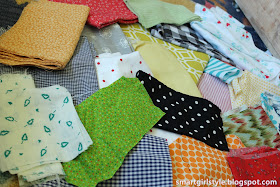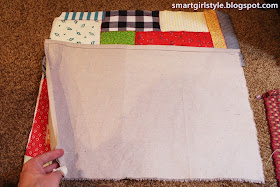If you're like me, you probably have a bajillion fabric scraps lying around.
(Hopefully, for your sake, that's where the similarities end...because I do things like burn dinner and "forget" to make my bed.)
Let's use those scraps to make something Mr. Anthro Paul Ojee would be proud of, shall we?
(For the record...I'm not proud of that last sentence. Apologies.)
Enter: DIY Patchwork Throw Pillow Tutorial. (Check out this post for other patchwork eye-candy, if you're so inclined.)
Transforming an old drab throw pillow into a patchwork accent pillow is cheery, it's bright, and it costs nothing, or very very little (if you need cording, for example, you might have to buy that).
Read more after the jump...
Start by gathering the fabric scraps that make your heart sing. I was very loose on my color scheme (translation: there's no color scheme), you could definitely tighten the look up if you wanted.
I went with bold colors for the most part. I think throwing in a few punches of black helped to keep the thing from reading too primary-colorish. But that might just be me.
Cut out random rectangular/square shapes.
Take your pillow form (or old pillow cover, if you've got one) and lay it on top of a medium- to heavy-duty fabric. I used solid white twill. This will be what you sew your patches onto to form the front of your pillow.
Cut to size. (I cut out two because I was doing two pillows.)
Next, I don't have photos for this, but here goes: take whatever fabric you want for the back of your pillow (I used a neutral cotton drop cloth) and cut a rectangle that is the same height as your white fabric but that is 1.5 the length. Cut this in half so that you have two pieces that are the same height as your white fabric but that are each 0.75(ish) the width. Hem just the edges that you cut very last, so that you end up with two pieces of pillow-back fabric, each with three raw edges and one hemmed edge. Set these aside for later.
Lay your white fabric square down. Arrange your cut fabric shapes, right sides up, directly onto it. (Nerd alert: This was the funnest part of this whole project for me. Like a puzzle with no "wrong" placement!) I tried to keep things loose and patchwork-y, varying the layout, direction, and exposed corners of all my pieces.
When you've got the look you want, pin every single corner securely. (What's wrong with my thumb, you ask? Let's just say that, instead of opening up a can of worms the other day, I opened up a can of corn...and that can in turn opened up my thumb. Quite deeply. The bandage is verrrry pretty, I know. Try not to let your jealousy distract you from the task at hand, though.)
There. All laid out, and all pinned down securely.
Now sew everything down. I used a wide zigzag stitch with a small stitch size. Be deliberate and accentuate every corner by using sharp stitches and 90-degree sewing turns. It takes longer, especially when you're doing it for, like, a quarter-inch bit of exposed fabric, but those little details help to make the end result awesome.
Yep. Still sewing.
I did a lot of lifting the sewing foot and moving the needle to another corner, so there was lots of thread trimming to be done by the end.
Oh, I should say here: make sure you have your piping ready at this point. Either do a google search to find out how to make your own (it's not hard, seriously), or buy some. Or do without. There's so much going on with a patchwork pillow, it would look great without piping, too.
Lay your finished patchwork pillow front down, right side up. Remember the two pillow-back pieces that you cut and hemmed earlier? Grab those. Take one and lay it on top of your patchwork piece, right side down and hemmed side crossing the middle of the patchwork piece. (The three raw edges will line up with the patchwork pillow front's raw edges.)
Take your other pillow-back piece and lay it, also right side down, on top of your growing pile o' fabric. Again, hemmed edge should be toward the center of the pillow, with outer raw edges aligned. You should have at least 4 inches of overlap on your two pillow-back pieces. I think I had closer to 8 inches.
If you're not doing piping, go ahead and pin these pieces together and sew around the whole thing, trim your corners, and flip it right-side-out. Done and done.
If you ARE doing piping, however, it gets a wee bit tricky if you're an amateur seamstress like I am. Here's what I did:
Take four pins and pin just the two pillow-back pieces together in the middle where the corners touch the fabric edge, where the red x's are in the photo below.
Now lift one edge of the two pieces of pillow-back, taking care not to shift their placement (see photo below). Take your piping and lay it down directly on top of your patchwork piece, raw edges of everything lined up. Leave an inch or two of the piping's end hanging out the side.
(To alleviate any confusion, I was too lazy to trim the smaller-check fabric in the photo below, and it's overhanging the edge of the white fabric piece, which is why everything does not appear to be lined up.)
Pin everything - the patchwork piece, piping, and two pillow-back pieces - in place right at this point. I stuck a pin in and started sewing where my finger is in the photo below.
I used a zipper foot to stitch the piping all around. At the corners, I cut the raw edge of the piping almost (but not quite) to the seam to allow for more bendable flexibility. (See photo below.)
Keep it going! It's going to look so good when you're done.
Remember how you left a bit of the piping hanging out the side when you started attaching the piping? You'll do the same thing with the end. Just make sure they completely meet up with each other, and preferably cross, before you angle the piping end out, so that when you turn the pillow right-side-out, there are no gaps in piping.
(This is making no sense, is it. Sighhhh...)
A view of the finished sewn-in piping, below. See the two cording ends? They crossed before heading outside the seam.
Home stretch. Trim excess fabric from the corners.
Thumb. Ugh.
Flip it right-side-out, thumb out your corners, and stick the pillow form inside. Should be nice and snug and awesomely patchwork pillow'd. Forgive the rapid (non)styling in the photo below; I ran out of time. But still, I heart them.
Annnnnd...just once more. For (e)kicks and (e)giggles.
(e)gross.




























These are adorable! I love the colour scheme (or lack thereof).
ReplyDeleteLove it!!
ReplyDeleteLove the colors! Love how cheerful they are and I am pinning this for sure!!! Love it!
ReplyDeleteI hope you will come link up to The CSI Project this week. The challenge is sewing. You can link up to 3 projects. Winners will be chosen by our guest judge.
Come on over!
www.thecsiproject.com
Ok, I think you should just get rid of that pillow... Why don't you just mail it to my house, and I will good care of it for you: call me for my mailing adreess.... OK?
ReplyDeleteheeheehee!
hugs x
Crystelle
Crystelle Boutique
{PS I love it!}
I am featuring your patchwork pillow today on my blog. Thanks for linking it up. The next link party starts in a few hours. I hope to see you again. Thanks.
ReplyDeletehttp://www.ifitsnotbaroquedesignblog.blogspot.com/
You amazed me again and again I had to feature you. thanks for sharing.
ReplyDeletep
What's with the bandaged thumb? Cut it with really sharp scissors?
ReplyDelete